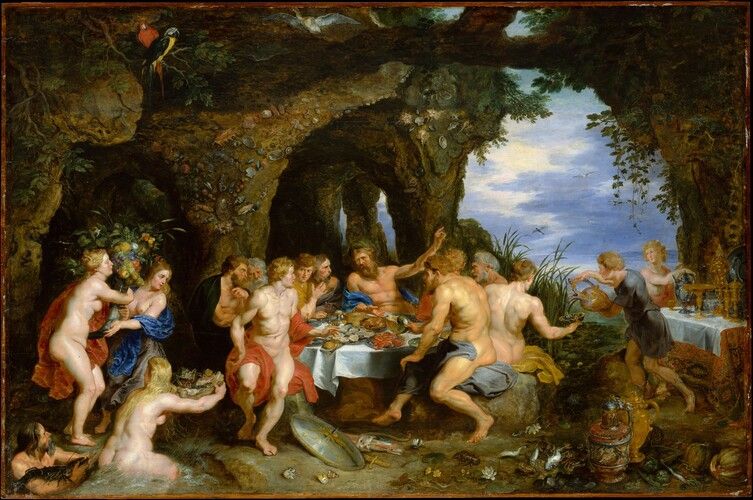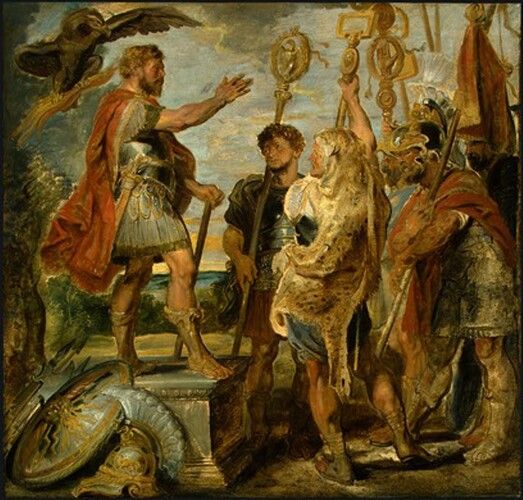
Peter Paul Rubens’ "The Fall of Icarus" captures the dramatic moment of Icarus and Daedalus mid-fall, emphasizing dynamic movement and expressive figures. Rubens’ use of chiaroscuro and energetic brushwork highlights the tension between ambition and downfall in this mythological scene.
The Fall of Icarus https://www.wikiart.org/en/peter-paul-rubens/the-fall-of-icarus-1636
22.11.2025 18:37 — 👍 3 🔁 1 💬 0 📌 0

This portrait of Marie de Medici by Peter Paul Rubens captures the opulence and power of the French queen consort through intricate details in her lavish clothing and regal pose. Painted during the Baroque period, the piece exemplifies Rubens' mastery in depicting texture and light.
Marie de Medici https://www.wikiart.org/en/peter-paul-rubens/marie-de-medici-1622
22.11.2025 16:19 — 👍 0 🔁 0 💬 0 📌 0

"Peter Paul Rubens' 'The Regent Militant: The Victory at Jülich' captures the triumphal spirit of Marie de' Medici riding a grand white horse, symbolizing power and victory. The composition is dynamic and theatrical, with allegorical figures like Victory and a personification of War illustrating the grandeur of her triumph."
13. The Regent Militant: The Victory at Jülich https://www.wikiart.org/en/peter-paul-rubens/the-triumph-of-juliers-1st-september-1610-1625
22.11.2025 14:56 — 👍 0 🔁 0 💬 0 📌 0

This artwork by Peter Paul Rubens, titled "The Fate Spinning Marie's Destiny," vividly portrays the mythological Fates weaving the life thread of Marie de' Medici. Rubens' masterful use of dynamic composition and vibrant colors reflects his dramatic Baroque style, emphasizing both the grandeur and the intimate details of celestial intervention in human destiny.
The Fate Spinning Maries Destiny https://www.wikiart.org/en/peter-paul-rubens/the-fate-spinning-maries-destiny-1625
22.11.2025 10:58 — 👍 0 🔁 0 💬 0 📌 0

Gift of Alvin and Irwin Untermyer, in memory of their parents, 1945
The Feast of Acheloüs https://www.metmuseum.org/art/collection/search/437525
22.11.2025 10:14 — 👍 0 🔁 0 💬 0 📌 0

This delicate sketch, believed to depict Nicolas Rubens, is a testament to Peter Paul Rubens' skillful use of line to capture the innocence and fragility of childhood. In this artwork, the soft shading and flowing lines express a sense of gentle realism, epitomizing Rubens' ability to convey life-like emotion in portraiture.
Nicolas Rubens https://www.wikiart.org/en/peter-paul-rubens/nicolas-rubens-1626
21.11.2025 18:26 — 👍 0 🔁 0 💬 0 📌 0

"The Raising of the Cross" by Peter Paul Rubens is a powerful depiction of Christ's crucifixion, characterized by dynamic movement and dramatic tension as soldiers strain to raise the cross. Created in the Baroque period, the painting demonstrates Rubens' mastery of anatomy and emotional intensity, capturing the anguish and spiritual significance of the scene.
The Raising of the Cross https://www.wikiart.org/en/peter-paul-rubens/the-raising-of-the-cross-1621
21.11.2025 15:13 — 👍 1 🔁 0 💬 0 📌 0

"St. Jerome in His Hermitage" by Peter Paul Rubens depicts the scholarly saint seated in a contemplative pose, surrounded by angelic figures. The vibrant hues and dynamic composition reflect Rubens' dramatic Baroque style, highlighting St. Jerome’s devotion and introspection.
St. Jerome in His Hermitage https://www.wikiart.org/en/peter-paul-rubens/st-jerome-in-his-hermitage-1609
21.11.2025 13:01 — 👍 0 🔁 0 💬 0 📌 0

This portrait, attributed to the circle of Peter Paul Rubens, depicts Charles the Bold, Duke of Burgundy, showcasing his power and authority through rich, detailed armor and an imposing stance. The use of dramatic lighting and dynamic composition reflects Rubens' Baroque style, conveying both the grandeur and turbulent nature of Charles' reign.
Charles the Bold, duke of Burgundy https://www.wikiart.org/en/peter-paul-rubens/charles-the-bold-duke-of-burgundy-1618
21.11.2025 12:28 — 👍 1 🔁 0 💬 0 📌 0

Susanna and the Elders http://collection.nationalmuseum.se/eMuseumPlus?service=ExternalInterface&module=collection&objectId=17599&viewType=detailView
21.11.2025 08:09 — 👍 0 🔁 0 💬 0 📌 0

"Helena Fourment" is a striking portrait by Peter Paul Rubens, showcasing his second wife adorned in an opulent gown with rich textures and intricate details. Painted with Rubens' signature use of warm colors and dynamic composition, the artwork exemplifies the Baroque era's grandeur and personal intimacy.
Helena Fourment https://www.wikiart.org/en/peter-paul-rubens/helena-fourment-1631
20.11.2025 19:59 — 👍 3 🔁 0 💬 0 📌 0

Peter Paul Rubens' "Lamentation (Christ on the Straw)" poignantly captures the sorrow and tenderness in the moments following Christ's crucifixion, as the figures surrounding him are depicted in varied emotional states. The painting showcases Rubens' mastery of drama and emotion through the use of chiaroscuro and the detailed depiction of mournful expressions.
Lamentation (Christ on the Straw) https://www.wikiart.org/en/peter-paul-rubens/lamentation-christ-on-the-straw-1618
20.11.2025 15:31 — 👍 1 🔁 0 💬 0 📌 1

"St. Domitilla with St. Nereus and St. Achilleus," attributed to Peter Paul Rubens, depicts the saints with palm branches, symbolizing martyrdom and victory over death. Rubens, known for his Baroque style, captures the figures with dramatic chiaroscuro and dynamic movement, surrounded by cherubs in a divine setting.
St. Domitilla with St. Nereus and St. Achilleus https://www.wikiart.org/en/peter-paul-rubens/st-domitilla-with-st-nereus-and-st-achilleus-1608
20.11.2025 14:04 — 👍 0 🔁 0 💬 0 📌 0

Harvard Art Museums/Fogg Museum, Gift of Meta and Paul J. Sachs
A Study for Christ for "The Elevation of the Cross" https://www.harvardartmuseums.org/collections/object/297062
20.11.2025 10:42 — 👍 1 🔁 0 💬 0 📌 0

"Adoration of the Shepherds" by Peter Paul Rubens beautifully captures the moment when shepherds visit the newborn Jesus, bathed in a warm, divine light. Rubens’ dynamic composition and use of rich, vibrant colors highlight the emotional intensity and spiritual significance of this biblical scene.
Adoration of the Shepherds https://www.wikiart.org/en/peter-paul-rubens/adoration-of-the-shepherds-1617
20.11.2025 09:33 — 👍 3 🔁 0 💬 0 📌 0

"The Resurrection of Christ" by Peter Paul Rubens is a dynamic triptych that captures the triumphant moment of Christ's resurrection with vivid energy. In the central panel, Rubens showcases the resurrected Christ emerging from the tomb, surrounded by soldiers in awe, flanked by two contemplative saints in the side panels.
The Resurrection of Christ https://www.wikiart.org/en/peter-paul-rubens/the-resurrection-of-christ-1612-0
19.11.2025 17:50 — 👍 1 🔁 0 💬 0 📌 0

"Landscape with Stone Carriers" by Peter Paul Rubens depicts a dramatic and dynamic scene where workers, amidst lush forests and rocky terrains, laboriously transport stones using horse-drawn carts. The painting showcases Rubens' masterful use of chiaroscuro to highlight the contrast between the illuminated figures and the dark, intricate landscape.
Landscape with Stone Carriers https://www.wikiart.org/en/peter-paul-rubens/landscape-with-stone-carriers-1620
19.11.2025 16:34 — 👍 2 🔁 0 💬 0 📌 0

Peter Paul Rubens' "Apotheosis of Henry IV and the Proclamation of the Regency of Marie de Medici" depicts a richly dynamic scene that celebrates the ascension and deification of King Henry IV, surrounded by allegorical figures. The painting also foregrounds Marie de Medici as she assumes the regency, highlighting Rubens' masterful use of color and composition to convey political power and divine right.
Apotheosis of Henry IV and the Proclamation of the Regency of Marie de Medici https://www.wikiart.org/en/peter-paul-rubens/apotheosis-of-henry-iv-and-the-proclamation-of-the-regency-of-marie-de-medici-1624
19.11.2025 12:55 — 👍 0 🔁 0 💬 0 📌 0

Peter Paul Rubens' masterpiece, "The Martyrdom of St. Sebastian," vividly depicts the saint tied to a tree, embodying dynamic tension and emotional depth typical of Baroque art. Surrounded by celestial beings, the composition captures Sebastian's serene expression amidst suffering, highlighting Rubens' skillful rendering of human anatomy and atmospheric drama.
The Martyrdom of St. Sebastian https://www.wikiart.org/en/peter-paul-rubens/the-martyrdom-of-st-sebastian-1608
19.11.2025 12:29 — 👍 1 🔁 0 💬 0 📌 0

24. Joanna of Austria, Grand Duchess of Tuscany, Mother of Marie De' Medici
24. Joanna of Austria, Grand Duchess of Tuscany, Mother of Marie De' Medici https://www.wikiart.org/en/peter-paul-rubens/24-joanna-of-austria-grand-duchess-of-tuscany-mother-of-marie-de-medici-1625
19.11.2025 08:08 — 👍 2 🔁 0 💬 0 📌 0

This portrait, titled "Portrait of Don Diego Messina," displays the refined draftsmanship typical of Peter Paul Rubens, known for his skillful depiction of texture and character. The artwork features Messina's expressive face and elaborate ruffled collar, showcasing the subtle use of shading and line that Rubens mastered during the Baroque period.
Portrait of Don Diego Messina https://www.wikiart.org/en/peter-paul-rubens/portrait-of-don-diego-messina-1627
18.11.2025 18:30 — 👍 1 🔁 1 💬 0 📌 0

In Peter Paul Rubens' "Mercury and Argus," the mythological narrative unfolds with Mercury stealthily approaching the watchful Argus, ready to free Io, depicted as a cow. The dynamic composition and vibrant colors are characteristic of Rubens' Baroque style, capturing the tension and drama of the scene.
Mercury and Argus https://www.wikiart.org/en/peter-paul-rubens/mercury-and-argus-1636
18.11.2025 17:28 — 👍 0 🔁 0 💬 0 📌 0

"St. George with St. Maurus and Papianus" by Peter Paul Rubens depicts the saints in grand attire, surrounded by heavenly cherubs and a dove symbolizing the Holy Spirit. The painting reflects Rubens' masterful use of dynamic composition and rich coloration to convey religious fervor and divine presence.
St. George with St. Maurus and Papianus https://www.wikiart.org/en/peter-paul-rubens/st-george-with-st-maurus-and-papianus
18.11.2025 14:00 — 👍 0 🔁 0 💬 0 📌 0

"Lot and His Daughters" by Peter Paul Rubens depicts a biblical scene showcasing Lot being offered wine by his daughters. The painting is a masterful example of Rubens' Baroque style, capturing dynamic movement and rich textures in a composition full of dramatic tension and moral complexity.
Lot and His Daughters https://www.wikiart.org/en/peter-paul-rubens/lot-and-his-daughters-1610
18.11.2025 10:50 — 👍 0 🔁 0 💬 0 📌 0

The "Portrait of Helena Fourment" by Peter Paul Rubens depicts his second wife, known for her beauty and frequently featured in his works. The drawing captures her with elegant detailing and soft lines, showcasing Rubens' renowned skill in portraying texture and form.
Portrait of Helena Fourment https://www.wikiart.org/en/peter-paul-rubens/portrait-of-helena-fourment-1638
18.11.2025 08:51 — 👍 1 🔁 0 💬 0 📌 0

"The Trinity Adored by the Duke of Mantua and His Family" by Peter Paul Rubens depicts the divine trio of God the Father, Jesus Christ, and the Holy Spirit above the noble figures of the Duke and his family, illustrating Baroque art's intricate blend of religious and dynastic symbolism. Rubens captures both heavenly grandeur and mortal devotion through dynamic composition and rich textures.
The Trinity Adored By The Duke of Mantua And His Family https://www.wikiart.org/en/peter-paul-rubens/the-trinity-adored-by-the-duke-of-mantua-and-his-family-1606
17.11.2025 19:56 — 👍 0 🔁 0 💬 0 📌 0

This artwork depicts a contemplative figure with a thoughtful expression, rendered with dramatic chiaroscuro, highlighting the character's intellectual aura—common elements in Peter Paul Rubens' portraits. The work captures the essence of Galileo Galilei, emphasizing the introspective and pioneering spirit of the famed astronomer.
Galileo Galilei https://www.wikiart.org/en/peter-paul-rubens/galileo-galilei-1630
17.11.2025 15:37 — 👍 1 🔁 0 💬 0 📌 0

In "Decius Mus Addressing the Legions," Peter Paul Rubens vividly captures the Roman general's stirring speech to his troops, emphasizing his dramatic gestures and the detailed classical armor. The painting reflects Rubens' mastery of Baroque dynamism and his skill in rendering complex historical narratives with emotional intensity.
Decius Mus Addressing the Legions https://www.wikiart.org/en/peter-paul-rubens/decius-mus-addressing-the-legions-1616
17.11.2025 13:14 — 👍 0 🔁 0 💬 0 📌 0

Charles H. and Mary F. S. Worcester Collection
The Wedding of Peleus and Thetis https://www.artic.edu/artworks/59956/
17.11.2025 11:52 — 👍 0 🔁 0 💬 0 📌 0

Samson and the Lion. Study http://collection.nationalmuseum.se/eMuseumPlus?service=ExternalInterface&module=collection&objectId=17609&viewType=detailView
17.11.2025 08:36 — 👍 0 🔁 0 💬 0 📌 0





























